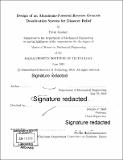Design of an aluminum-powered reverse osmosis desalination system for disaster relief
Author(s)
Godart, Peter T.(Peter Tully)
Download1128180615-MIT.pdf (14.31Mb)
Other Contributors
Massachusetts Institute of Technology. Department of Mechanical Engineering.
Advisor
Douglas P. Hart.
Terms of use
Metadata
Show full item recordAbstract
Fuel generated from highly energy-dense aluminum debris (23.3 kWh/L) is explored here as a means for producing electricity and clean water for disaster relief and preparedness. Energy is extracted from aluminum by first treating it with a minimal surface coating of gallium and indium (<3% by mass) and then reacting it with water to produce hydrogen, which can supply a fuel cell or internal combustion engine to generate electricity, and heat, which can be used to desalinate and purify seawater or contaminated fresh water. To use aluminum debris as fuel, it is necessary to first understand which of the many possible aluminum-water reactions occurs at given a temperature and pressure in order to accurately model such quantities as the heat released and the amount of water required stoichiometrically for the reaction to proceed. A new thermodynamics analysis is presented here that predicts these quantities by minimizing the Gibbs free energy over the possible reactions to determine which is most favorable under a wide range operating conditions. Reaction experiments at the extremities of this range validate these results. This new aluminum-water reaction model enables the design of a robust and minimally complex system that uses the heat released in this reaction to desalinate seawater. The system presented here uses a novel process called Heat-Driven Reverse Osmosis (HDRO), in which the release of thermal energy in an enclosed vessel pressurizes a working fluid up the high pressures required to drive reverse osmosis. Using the aluminum-water reaction as the heat source for this process, the theoretical upper limit performance ratio is shown to be 41 for 3.5% salinity seawater and maximum operating pressure of 138 bar, and an unoptimized prototype has achieved a performance ratio of 3. Additionally, because the hydrogen produced in the aluminum-water reaction is not consumed in this process, it can be used to generate electricity or desalinate additional water, further increasing the system wide efficiency. Thus, in addition to being well-suited for disaster relief, this technology is a potentially attractive option for large-scale desalination in drought prone regions as well.
Description
Thesis: S.M., Massachusetts Institute of Technology, Department of Mechanical Engineering, 2019 Cataloged from PDF version of thesis. Includes bibliographical references (pages 103-105).
Date issued
2019Department
Massachusetts Institute of Technology. Department of Mechanical EngineeringPublisher
Massachusetts Institute of Technology
Keywords
Mechanical Engineering.